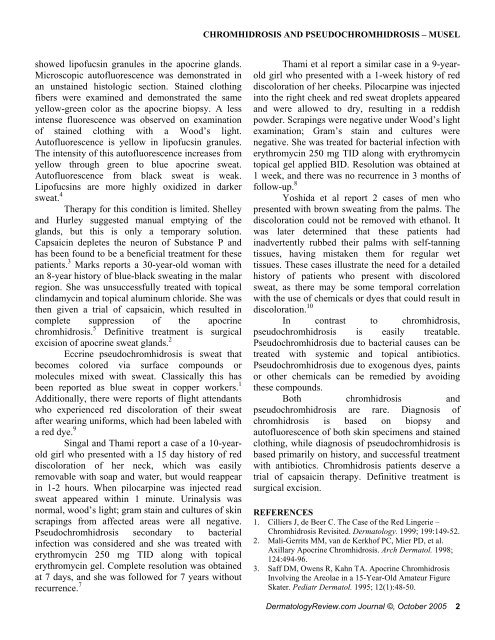chromhidrosis and pseudochromhidrosis - Dermatology Review
chromhidrosis and pseudochromhidrosis - Dermatology Review
chromhidrosis and pseudochromhidrosis - Dermatology Review
You also want an ePaper? Increase the reach of your titles
YUMPU automatically turns print PDFs into web optimized ePapers that Google loves.
showed lipofucsin granules in the apocrine gl<strong>and</strong>s.<br />
Microscopic autofluorescence was demonstrated in<br />
an unstained histologic section. Stained clothing<br />
fibers were examined <strong>and</strong> demonstrated the same<br />
yellow-green color as the apocrine biopsy. A less<br />
intense fluorescence was observed on examination<br />
of stained clothing with a Wood’s light.<br />
Autofluorescence is yellow in lipofucsin granules.<br />
The intensity of this autofluorescence increases from<br />
yellow through green to blue apocrine sweat.<br />
Autofluorescence from black sweat is weak.<br />
Lipofucsins are more highly oxidized in darker<br />
sweat. 4<br />
Therapy for this condition is limited. Shelley<br />
<strong>and</strong> Hurley suggested manual emptying of the<br />
gl<strong>and</strong>s, but this is only a temporary solution.<br />
Capsaicin depletes the neuron of Substance P <strong>and</strong><br />
has been found to be a beneficial treatment for these<br />
patients. 3 Marks reports a 30-year-old woman with<br />
an 8-year history of blue-black sweating in the malar<br />
region. She was unsuccessfully treated with topical<br />
clindamycin <strong>and</strong> topical aluminum chloride. She was<br />
then given a trial of capsaicin, which resulted in<br />
complete suppression of the apocrine<br />
<strong>chromhidrosis</strong>. 5 Definitive treatment is surgical<br />
excision of apocrine sweat gl<strong>and</strong>s. 2<br />
Eccrine pseudo<strong>chromhidrosis</strong> is sweat that<br />
becomes colored via surface compounds or<br />
molecules mixed with sweat. Classically this has<br />
been reported as blue sweat in copper workers. 1<br />
Additionally, there were reports of flight attendants<br />
who experienced red discoloration of their sweat<br />
after wearing uniforms, which had been labeled with<br />
a red dye. 9<br />
Singal <strong>and</strong> Thami report a case of a 10-yearold<br />
girl who presented with a 15 day history of red<br />
discoloration of her neck, which was easily<br />
removable with soap <strong>and</strong> water, but would reappear<br />
in 1-2 hours. When pilocarpine was injected read<br />
sweat appeared within 1 minute. Urinalysis was<br />
normal, wood’s light; gram stain <strong>and</strong> cultures of skin<br />
scrapings from affected areas were all negative.<br />
Pseudo<strong>chromhidrosis</strong> secondary to bacterial<br />
infection was considered <strong>and</strong> she was treated with<br />
erythromycin 250 mg TID along with topical<br />
erythromycin gel. Complete resolution was obtained<br />
at 7 days, <strong>and</strong> she was followed for 7 years without<br />
recurrence. 7<br />
CHROMHIDROSIS AND PSEUDOCHROMHIDROSIS – MUSEL<br />
Thami et al report a similar case in a 9-yearold<br />
girl who presented with a 1-week history of red<br />
discoloration of her cheeks. Pilocarpine was injected<br />
into the right cheek <strong>and</strong> red sweat droplets appeared<br />
<strong>and</strong> were allowed to dry, resulting in a reddish<br />
powder. Scrapings were negative under Wood’s light<br />
examination; Gram’s stain <strong>and</strong> cultures were<br />
negative. She was treated for bacterial infection with<br />
erythromycin 250 mg TID along with erythromycin<br />
topical gel applied BID. Resolution was obtained at<br />
1 week, <strong>and</strong> there was no recurrence in 3 months of<br />
follow-up. 8<br />
Yoshida et al report 2 cases of men who<br />
presented with brown sweating from the palms. The<br />
discoloration could not be removed with ethanol. It<br />
was later determined that these patients had<br />
inadvertently rubbed their palms with self-tanning<br />
tissues, having mistaken them for regular wet<br />
tissues. These cases illustrate the need for a detailed<br />
history of patients who present with discolored<br />
sweat, as there may be some temporal correlation<br />
with the use of chemicals or dyes that could result in<br />
discoloration. 10<br />
In contrast to <strong>chromhidrosis</strong>,<br />
pseudo<strong>chromhidrosis</strong> is easily treatable.<br />
Pseudo<strong>chromhidrosis</strong> due to bacterial causes can be<br />
treated with systemic <strong>and</strong> topical antibiotics.<br />
Pseudo<strong>chromhidrosis</strong> due to exogenous dyes, paints<br />
or other chemicals can be remedied by avoiding<br />
these compounds.<br />
Both <strong>chromhidrosis</strong> <strong>and</strong><br />
pseudo<strong>chromhidrosis</strong> are rare. Diagnosis of<br />
<strong>chromhidrosis</strong> is based on biopsy <strong>and</strong><br />
autofluorescence of both skin specimens <strong>and</strong> stained<br />
clothing, while diagnosis of pseudo<strong>chromhidrosis</strong> is<br />
based primarily on history, <strong>and</strong> successful treatment<br />
with antibiotics. Chromhidrosis patients deserve a<br />
trial of capsaicin therapy. Definitive treatment is<br />
surgical excision.<br />
REFERENCES<br />
1. Cilliers J, de Beer C. The Case of the Red Lingerie –<br />
Chromhidrosis Revisited. <strong>Dermatology</strong>. 1999; 199:149-52.<br />
2. Mali-Gerrits MM, van de Kerkhof PC, Mier PD, et al.<br />
Axillary Apocrine Chromhidrosis. Arch Dermatol. 1998;<br />
124:494-96.<br />
3. Saff DM, Owens R, Kahn TA. Apocrine Chromhidrosis<br />
Involving the Areolae in a 15-Year-Old Amateur Figure<br />
Skater. Pediatr Dermatol. 1995; 12(1):48-50.<br />
<strong>Dermatology</strong><strong>Review</strong>.com Journal ©, October 2005 2


